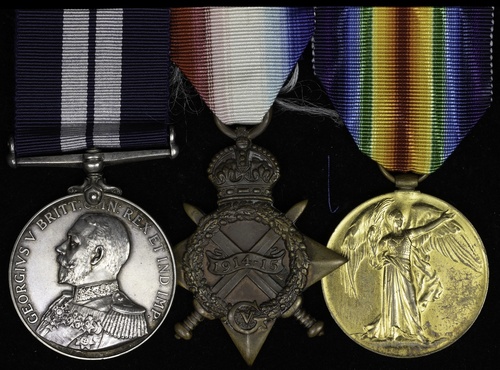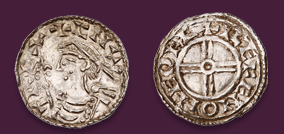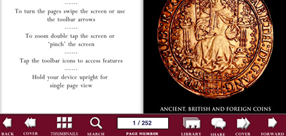
Auction: 25111 - Orders, Decorations and Medals - e-Auction
Lot: 678
'I have the honour to draw your attention to the behaviour of my ship's company, or rather what was left of them. It was simply splendid. I can find no other word for it. When the ship had gone down, and we were all in the water, the men were singing, "Tipperary" and a hail of "Are we downhearted?" drew the usual reply from all hands. When they were not singing, they were cheering …'
Commander Maurice Blackwood, D.S.O., R.N., late captain of the Q-ship Stonecrop, pays tribute to his gallant crew, among them C.P.O. Olding.
A rare Great War 'Q Ship 1917' D.S.M. group of three awarded to Chief Petty Officer C. W. Olding, Royal Navy who was serving on H.M.S. Stonecrop when she engaged U-151 on 17 September 1917
The next day in what became a famous chapter of Q-ship history, some of her crew subsequently survived their ordeal with U-43, after a week adrift in a hastily made raft, a story movingly recalled in the pages of Q Boat Encounters, by Harold Auten, V.C.
Distinguished Service Medal, G.V.R. (179704. C.W. Olding, P.O.1cl. Atlantic Ocean. 17 Sept.1917.); 1914-15 Star (179704. C. Olding. P.O.1., R.N.); Victory Medal (179704 C. Olding. C.P.O. R.N.), light contract marks, very fine (3)
D.S.M. London Gazette 17 November 1917, the original recommendation states:
'HMS Stonecrop (Q Ship) action with enemy submarine 17 September 1917. Went away as mate of ship in 'abandon ship' party and assisted Lieutenant Booth in a most able manner'.
Charles William Olding was born at Titchfield, Hampshire on 5 September 1877, the son of Charles and Martha Olding. A gardener he joined the Royal Navy as a Boy 2nd Class on 30 April 1894. He had a succession of shore and sea-based appointments prior to the Great War, with promotions to Able Seaman in 1897, Leading Seaman in 1905 and P.O. 2nd class in 1907. Olding was stationed ashore until 5 August 1917.
In Peril on the Sea
His next appointment as Chief Petty Officer was aboard the Q-ship Stonecrop, which commenced on 6 August 1917 and ended in heavy loss of life off Ireland on 18 September 1917 when Stonecrop was torpedoed by U-43.
Originally the collier Glenfoyle, she was converted for service as a 'Q-Ship' in April 1917 and fitted with one visible 6-pounder gun capable of firing only in the aft direction (as was legitimate defence for a merchant ship) but also with a concealed 4-inch gun, 12-pounder howitzers for projecting bombs, and torpedo tubes.
Commanded by the 'sometimes fiery' Maurice Blackwood, D.S.O., R.N., Stonecrop had fought a classic Q-ship action against U-151 the previous day, when she obtained numerous hits on her adversary, an action described at length by Harold Auten in his Q Boat Adventures.
On 17 September 1917, when some 300 miles south-west of Co. Kerry, she sighted a submarine (U-151) on the surface at 14000 yards distance. The submarine opened fire and Stonecrop turned away at her top speed of 7 knots, sending out S.O.S. signals. The submarine followed, overtaking and firing, but without making any direct hits. After half an hour of this, Stonecrop lighted her Smoke Apparatus, simulating a very realistic fire, and sent off her 'panic party'. The submarine then submerged but reappeared later and circled the ship at 600 yards. Stonecrop opened fire with her 4-inch gun, scoring several hits. The submarine then moved away, to sink stern-first. She surfaced again briefly before finally sinking. Her conning-tower hatch had not been opened and no wreckage appeared, just oil and scum, but Stonecrop's Captain was convinced that she had been sunk. The Admiralty awarded £1000 to be distributed amongst the crew.
Auten likewise describes Stonecrop's final action just 24 hours later, in which she was torpedoed by the U-43. The resultant explosion demolished the bridge, wheelhouse and wireless office and instantly killed five ratings and, within a short space of time, Stonecrop slipped beneath the waves. The surviving crew took to two boats and a raft but because of the destruction of the wireless office it had not been possible to send out an S.O.S. message. Blackwood sent off one of the boats to summon help from land and his own boat, having become separated from the raft in heavy seas, was rescued by a passing steamer on 20 September.
The fate of those who took to the raft - three officers and 20 ratings - was less fortunate. As each day passed, with no sign of any help, their numbers dwindled on account of the cold, exposure and lack of water, madness, too. Finally, nearly a week after the loss of the Stonecrop, just two surviving officers and eight ratings were rescued from the raft by a patrol boat.
As Auten concludes:
'Out of a total complement of ninety-nine (11 officers and 88 men) that had manned the Stonecrop, four officers and forty men had lost their lives.'
Olding, one of the lucky ones, was shore based for the remainder of the war being shore pensioned on 10 March 1920 after an eventful period of active service.
He died at Portsmouth in September 1933.
Subject to 20% VAT on Buyer’s Premium. For more information please view Terms and Conditions for Buyers.
Sold for
£900
Starting price
£550




